
I just want to do a quick Sunday feature page this week, as I got plenty of walking in and watched plenty of baseball and football. A few weeks ago I went over to the 42nd Street shuttle that connects Times Square and Grand Central because I wanted to document the not insignificant changes that have been made to what’s basically the shortest subway line in the city.
Of all of New York City’s hundreds of subway stations, the Times Square Shuttle station is the one I’ve always found the most fascinating. The original IRT subway constructed from 1900-1904 was basically S or Z-shaped and ran from City Hall north on Elm (later Lafayette), 4th Avenue, Park Avenue, then west on 42nd and north again on Broadway to a terminus at 145th Street. Of course more stations and lines were built in short order from 1905-1908. Times Square is one of the Original 28 stations and surprisingly, in 1904, was built as a local station, with two platforms on either side and four tracks, two locals and two expresses. Thus, original IRT trains between 1904 and 1918 ran express from the original Grand Central stop all the way to 72nd Street, making two turns in between (see this map for the route).
When a second impetus of building subways and elevated lines began as part of the Dual Contracts funding the IRT and helping to originate the BMT (after the 1918 Malbone Street Wreck) in the early 1910s, that “S/Z” became an “H” as the original IRT was run up to the Bronx via Lexington and then south to Brooklyn along 7th Avenue and Varick Street. This caused big changes at the original Times Square station, which became orphaned as a result of those uptown and downtown expansions. It became a shuttle train running between Times Square and Grand Central, with transfers to nearly a dozen other subway lines. At first these transfers were not free: they only became so after the subways were unified in 1940, with the true interconnectedness with free transfers not achieved until the late 1940s.
What happened was that one of the tracks, Track 2, was removed from service and a platform constructed over it while Track 1, the southernmost, retained a connection with the Lexington Avenue IRT. Track 4, meanwhile, retained a connection with the Broadway/7th Avenue IRT, but it was awkward for passengers to accessits platform. They had to walk around the western end of Tracks 1, 3 and 4 and then over a metal bridge plate to access the Track 4 platform, which was the original local northbound platform. That metal bridge plate was removed by MTA personnel when trainsets had to be moved from the Shuttle onto the Broadway/7th Avenue line.
I’ll tell you what changes were made a bit later on. First…
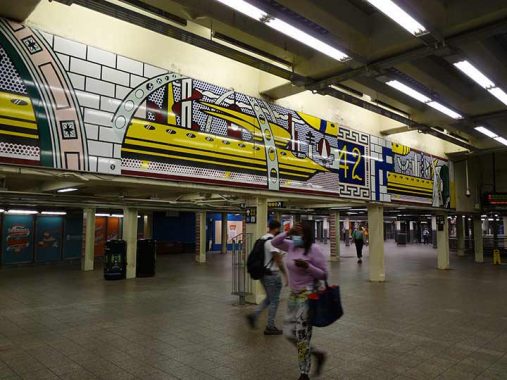
I reached the Shuttle platform by making a transfer from the #7 and to do so, you pass under this huge mural, executed by famed Pop artist Roy Lichtenstein in 1994; it’s simply called “Times Square Mural.”
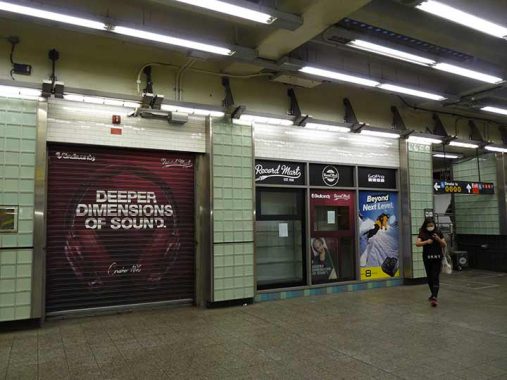
Most of the years I have been coming to the Times Square station — and I’ve been doing it since I was a little kid with my parents, so it’s over 50 years — there has been a record store in the station, between the stairs going to the BMT platforms handling the N/R/Q/W trains and the Shuttle area. And there was until just recently, till the Covid-19 Pandemic cooked Record Mart’s goose. I’d have to think that since there’s still a market for recordings pressed on vinyl some incarnation of a record store will return when the Pandemic is done. Whenever that may be.
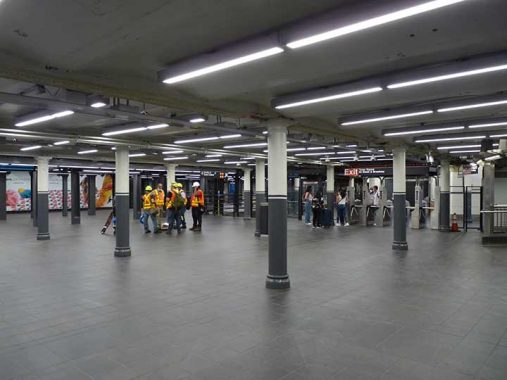
Here’s a look at the vast “foyer” that leads to the Shuttle platform area. Formerly, the “sidewalk” was paved unevenly, patched from years of piecework here and there. Recent changes have seen a more even, uniform treatment introduced; for example, there had been some skylights visible from the walkway that have since been removed. You can see them on this FNY page.
If you look at early photos of IRT stations, the station columns were painted as you see them here, with color halfway up the column with a thin stripe on top of that. The new paint scheme is gray with just a hint of blue. this seems to be the go-to color in NYC infrastructure lately; you can also see it in High Line Park, opened in stages between 2009 and 2020.

I may as well reveal it. What the MTA did this year is remove Track 3 and straighten (to a large degree) Tracks 1 and 4, removing the gap fillers that allowed safe egress and entrance on curved platforms. The gap fillers weren’t as noticeable was they are at the 14th Street 4/5/6 trains and former South Ferry terminal because they were located under the platform instead of extending it outward. Removing Track 3 created a much wider center platform at Times Square and especially at Grand Central.
What I’m showing here is the west end of the Times Square shuttle platform, and construction people were still working on the station behind the pizza-decorated barrier. Behind here were some of the station’s more noted oddities, such as the remains of a doorway that allowed bundles of newspapers to be picked up and dropped off from New York Times offices located directly above, as well as that metal plate crossover I was talking about. I don’t know what will become of that or if the MTA still wants to move trainsets out of the shuttle station from here (subway historian Andy Sparberg, help me out here in Comments).

Here’s a look at that new, widened center platform. The diagonal braced columns were originally along a trackway and I’m glad the MTA retained this design element.
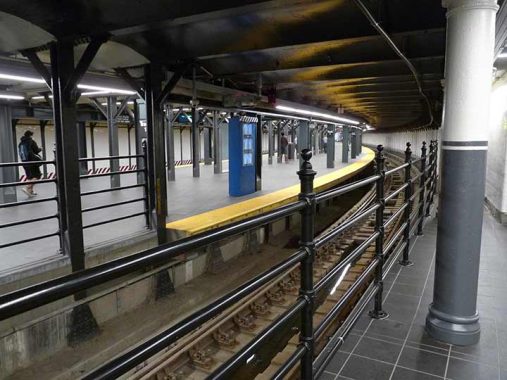
Another design element I’m glad the MTA stuck with was this fancy fence with the knobbed finials on the westbound platform, formerly the southbound Times Square platform.

Though the MTA has not retained any of the original “Times Square” large mosaic/terra cotta station ID plaques (it used to, on the Track 4 platform) there is a smidgen of the old design here, as well as a pair of “42” terra cotta friezes.
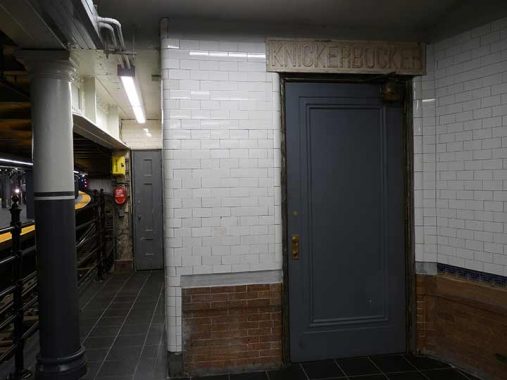
You didn’t think the MTA would get rid of the old Knickerbocker “door to nowhere” that formerly got you into the Knickerbocker Hotel (still standing on 7th and West 42nd)? Of course you didn’t.

The MTA has an information board delineating the TSS station’s complicated history and depicts one of those mosaic/terra cotta tablets I mentioned.
A look at what is now a considerably less-complicated Times Square Shuttle station, with only Tracks 1 and 4 remaining. Future generations of passengers will scratch their heads and wonder where the heck tracks 2 and 3 are and only historians will be able to explain their absence. I think the MTA should have gone ahead and renamed Track 4 Track 2. It’s not like Tracks 2 and 3 are ever coming back. The MTA tends to be hidebound about nomenclature though. Take IRT line numbering. When skip stop service was briefly tried on the #1 Broadway local, the skip stop train was tabbed #9. They could have called it the #8, as that was the next number after the #7 Flushing Line, but… #8 had already been claimed, by the orphaned 3rd Avenue El in the Bronx, where service ended… in 1973.
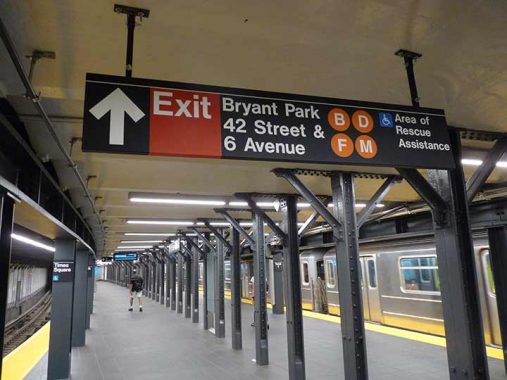
Something new has been added: when Track #3 was eliminated and turned into a platform, the MTA saw an opportunity to extend a corridor west to 6th Avenue and create a transfer to the IND lines that run there, the B/D/F/M trains. Thus…
A “gallery” in more ways than one was built along the former trackway to allow a free transfer to the IND from not only the Shuttle, but also the Broadway/7th Avenue IRT 1/2/3 and the BMT Broadway N/Q/R/W. That’s a lot of free transfers.
Prior to just recently, the only Nick Cave I knew about was the Australian rocker known since the 1980s with the Birthday Party, Bad Seeds, and solo work. However, there’s another Nick Cave, an artist from Missouri best known for his “soundsuits,” what the New York Times calls “wearable fabric sculptures made of materials such as twigs, wire, raffia and even human hair that often generate sound when the wearer moves.” (I seem to recall the two Nick Caves teaming up for a project a couple of years ago). Several mosaics of figures wearing Soundsuits, as well as a video boards showing them in action, can be seen in the new transfer corridor.
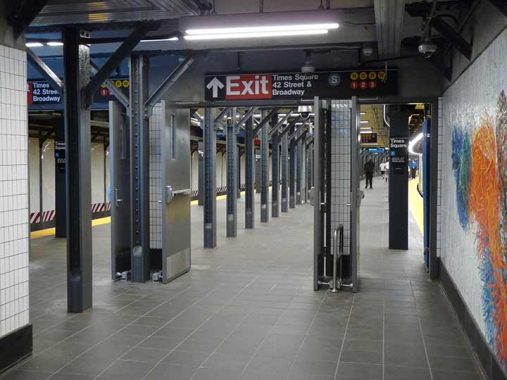
Returning to the Times Square shuttle station…
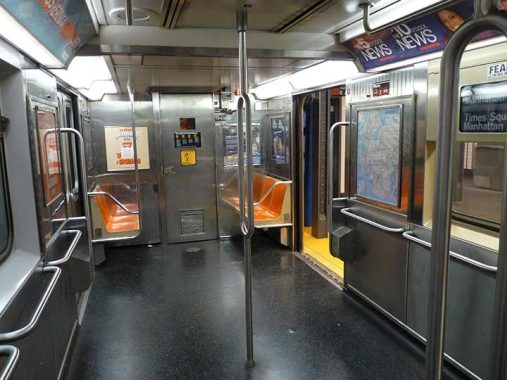
It was time to take the short ride in an R62 car to Grand Central. Some years ago, the MTA removed most of the seats ostensibly to relieve crowding (not a problem during the Pandemic). However, this does mean disabled or compromised passengers are out of luck if they need to sit down; there are only 4 seats per car now.
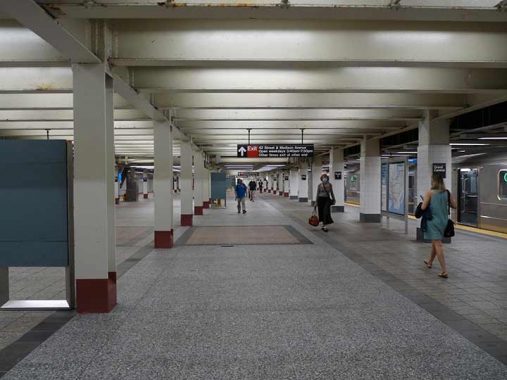
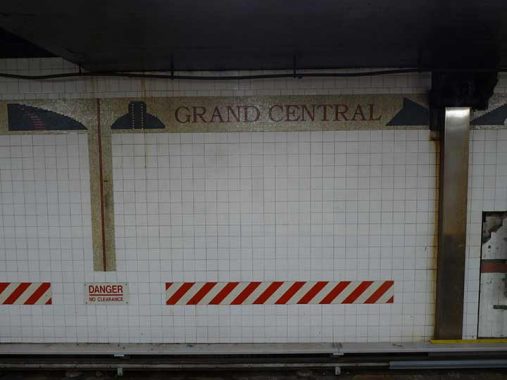
The Grand Central shuttle platform, minus Track 3 and with a widened platform, has likely the widest central island platform in the subways. Unfortunately it still has its 1980s wall mosaics, which look like crude computer art from the same period.
A new escalator/staircase has been created to get passengers up to the new skyscraper One Vanderbilt and into Grand Central Terminal. The signage here matches the Garamond style from GCT. Note the Long Island RR reference: that divison will also be running trains into GCT now scheduled for the end of 2022. We shall see…
Errors? I’m listening, lay ’em on in Comments.
As always, “comment…as you see fit.” I earn a small payment when you click on any ad on the site.
10/3/21


26 comments
Sorry to see the entrance at 43rd and Broadway closed, but I understand we walked over Bridge Plate which has been eliminated at Track 4. And we won’t see the #1 uptown trains pass. Maybe they’ll be revealed when the plywood is removed?
Whenever East Side Access is completed doesn’t really matter any longer because WFH has rendered it obsolete.
The GCT shuttle station platforms had an off-network feel; I connected in my mind the Times Square S station to the rest of the system but did not connect the GCT S in the same way. The color squares on the tiles at GCT somehow seemed to reinforce this. GCT at least in the 70s was alot cleaner and brighter.
Hello Kevin, this is Andy Sparberg.
Will try to find out more and get back to you via comments or FB messenger.
In the meantime, I can tell you that Track 4’s connection to the Uptown IRT #1 must remain along with the metal bridge crossover. Otherwise there would be no way to move the Shuttle’s equipment to or from 207th St. yard for inspections, repairs, and heavy cleaning. Without that bridge crossover, the train on Track #4 would be there forever. The unanswered question is – will this location be permanently closed to the public? I hope not, as the view from the crossover to the IRT #1, 2, 3 trains is one of my favorite subway views. While the old street entrance at this location (43d and Broadway, now in the middle of the Times Square pedestrian area) has been removed, a newer and wider one is still under construction and will hopefully open later this year.
Track #1’s only connection to the rest of the subway world remains at its east end where the original 1904 tunnel connects the Shuttle to the downtown Lexington IRT. From there, shuttle equipment travels to Livonia Yard in Brooklyn, at the end of the #3 line, for required maintenance. The shuttle equipment on Track #1 can’t go anywhere else.
Grammar error. was should be as.
The gap fillers weren’t as noticeable was they are at the 14th Street 4/5/6 trains and former South Ferry terminal because they were located under the platform instead of extending it outward.
Hey Kevin,
Grand Central-bound trains on Track 1 can continue south and Times Square-bound trains on Track 4 can continue north. There is no more bridge, the platform at each station is a large island platform between tracks 1 and 4, with the old track 4 island platform out of service.
Source with maps: https://en.wikipedia.org/wiki/42nd_Street_Shuttle#Track_layout
I W
would think the new configuration would mean the metal bridge over track 4 will no longer be needed, it was required to access the old uptown local platform that has now been abandoned.
I used to take the A train to the city. It doesn’t sound like they did anything to make getting from the A to the S less onerous. Getting to and from the S takes so much time, I found it faster to just walk the avenues from 8th to GCT or switch from the A to the B/D at 42nd street. Still, glad to see the MTA fixing up the stations; they were long overdue for a face lift.
I wonder why none (that I can find) of the many stories on this subject don’t show, at the east end of the Grand Central shuttle platform, the entrance to One Vanderbilt that has an elevator that can get the disabled up to the main GCT level without stairs or having to walk all the way to Lexington Ave. A huge part of the shuttle project was about ADA accessibility for the shuttle yet no one mentions this crucial part.
I have a comment. about the subway transfers at 42nd St. After the 42nd St. Shuttle debuted in 1918, free transfers were permitted but only between the shuttle and other IRT routes – the #1, 2, 3, and 7 at Times Square, and the #4, 5, 6, and 7 at Grand Central (the numbers were not used in those days but I’m including here for clarity). Free transfers between the IRT and BMT at Times Square did not exist until 1948, eight years after the IRT and BMT came under common NYC municipal ownership. The reason was that the fare was raised from five to ten cents in 1948, and to ease the burden on the riding public, thirteen free transfer points were established where two or three of the subway divisions (IRT, BMT, IND) intersected. Times Square was one, two other examples were 59th-Columbus Circle (IRT, IND) and 59th-Lexington (IRT and BMT). Grand Central did not qualify because it only hosts one division – the IRT.
The free transfer under 41st St. between the #1, 2, 3, 7 and the IND 8th Ave. A, C, and E trains was created in 1988, but the passageway was there when the IND opened in 1932.
My father was stationed at Fort Hamilton during World War II but was allowed to live in an Upper Manhattan apartment after he married my mother. He traveled by IRT between 103rd St. and Times Square, and by BMT between Times Square and 95th St./Brooklyn. I distinctly remember him telling me that he had to pay two fares each way while he was in the Army.
I’m surprised no one else mentioned this scene from “The Franch Connection”:
https://www.bing.com/videos/search?q=french+connection%2ffrog+1&docid=607999354442621551&mid=5084A5FCC23E11628E545084A5FCC23E11628E54&view=detail&FORM=VIRE
On a side note: the 1950 Bugs Bunny cartoon “Hurdy-Gurdy Hare,” directed by Bob McKimson and set in Manhattan, has two specific subway callouts, one of which is semi-relevant here. One, when Bugs is shoving the gorilla that’s his opponent in this cartoon, involves Bugs winking at the audience and noting that he used to “woik on the shuttle from Times Square to Grand Central.” Right before this, when the gorilla comes out from a sidewalk hole he’d fallen into, you see him as a straphanger with his arm through a “Bronx Express” window. (Musical director Carl Stalling plays “42nd Street” during these bits.) It’s worth noting that the writer of the cartoon, Warren Foster, was a New York City native.
https://www.dailymotion.com/video/x4jxjn1
I fully understand the need to update the Times Square station but to me, a lot of character was lost in the renovation. The old station had curios of the original IRT virtually everywhere you looked. The platform alongside Track 4 looked like it was in virtually the same configuration as it was in 1904. There were marks in the floor of structures long gone. The skylights for the below-platform transfer passage hinted at a priceless relic. The Knickerbocker door is now walled off (although the Knickerbocker sign remains). And the view into the tunnel showing the stanchions in the original IRT configuration and the passing 21st century trains provided a marvelous contrast. These are all gone now. Times Square is now just another antiseptic station.
agreed
I never got why short subway lines are referred to as shuttles, so it would be nice to know the story behind that.
The term shuttle may stem from “shuttlecock” which is the device used on a loom in weaving. It only goes back and forth on the loom for a very short distance.
The 42nd St Shuttle only goes a short distance with only 2 stops (as opposed to a full line). Although the MTA does use it to describe bus service replacing subway service during construction projects and certain subway service of more than just 2 stops (Dyre Av, Myrtle Av, Franklin Av, Rockaway Park, Lefferts-Euclid).
The IRT “8” was originally intended for IRT Times Square to Astoria service which was made moot by the transfer to the Astoria line to the BMT Division in 1949.
The Bronx 3rd Avenue Elevated received the “8” designation in the late 1960s. The 1948 R12s ran on the line from 1969-1973 (end of service) displayed a “SHUTTLE” route designation and not an “8.”
The IRT “9” was the original designation of the East 180th Street-Dyre Avenue shuttle. In 1957, the shuttle, part of the former New York, Westchester and Boston Railway (1912-1937) route, was connected to the IRT White Plains line (now 2 & 5 trains.)
I have always wondered why do you need a shuttle when you can just take the 7 train?
There is a lot of crosstown subway traffic at 42nd St. The #7 line is much deeper below ground than the shuttle, thus the interchanges between the #7 and the north south subways at Times Square and Grand Central require many stairs or escalators. Very inconvenient and not user-friendly if one is transferring immediately. And until the pandemic occurred the #7 was crowded enough with traffic to and from Queens.
So if I understand correctly, because of the connection from Times Square to Sixth Avenue (B, D, F, M), one can now walk underground from Eighth Avenue (A, C, E) to Fifth Avenue (7) without having to pay an additional fare.
Correct. From Fifth to Eighth Avenues. The same as the width of Central Park!
Just a comment – the original platform on track 4 at Times Square did not have gap fillers. For whatever reason the cars did not leave such a wide gap as they did on track 1 or on the added platform for track 3.
I did that just to see what it involved. It is not a easy walk. There are lots of stairs involved . From the shuttle you have to go down to either 6 Av line platform and up stairs to the 7 line passageway.
Thanks for the information. Keep up the Good work!
Just an update – I was at the shuttle about a week ago. At the northern end of the platform 2 sets of parallel lines were pasted on the platform indicating where tracks 2 and 3 used to be. The lines are about 25 feet long.